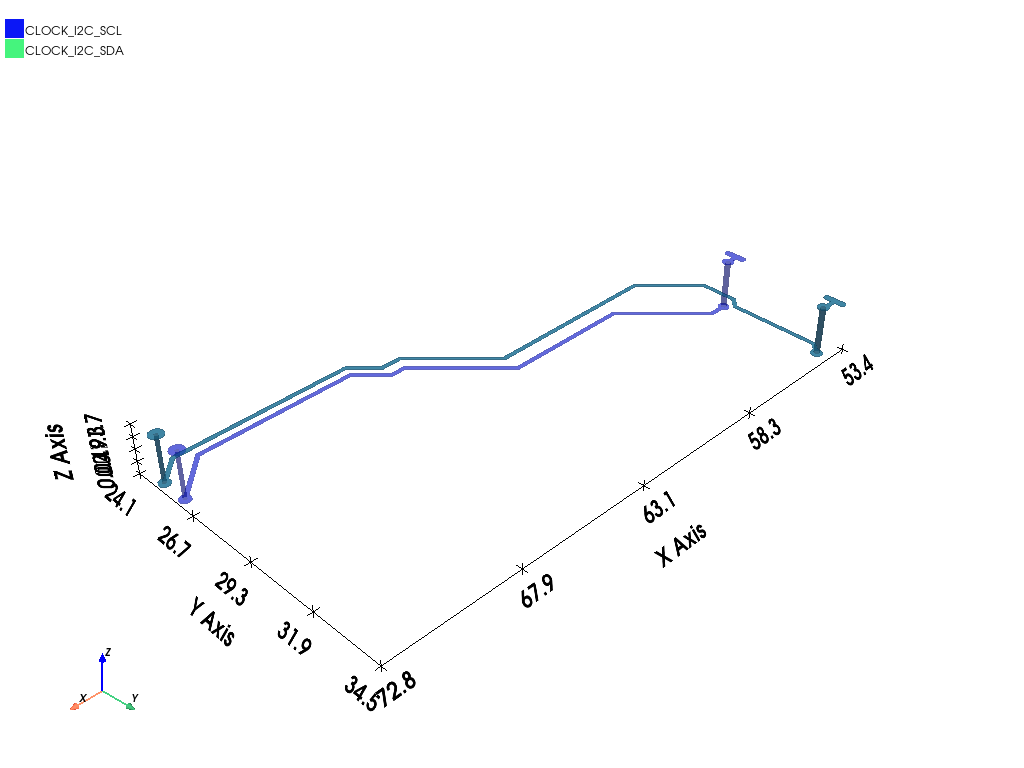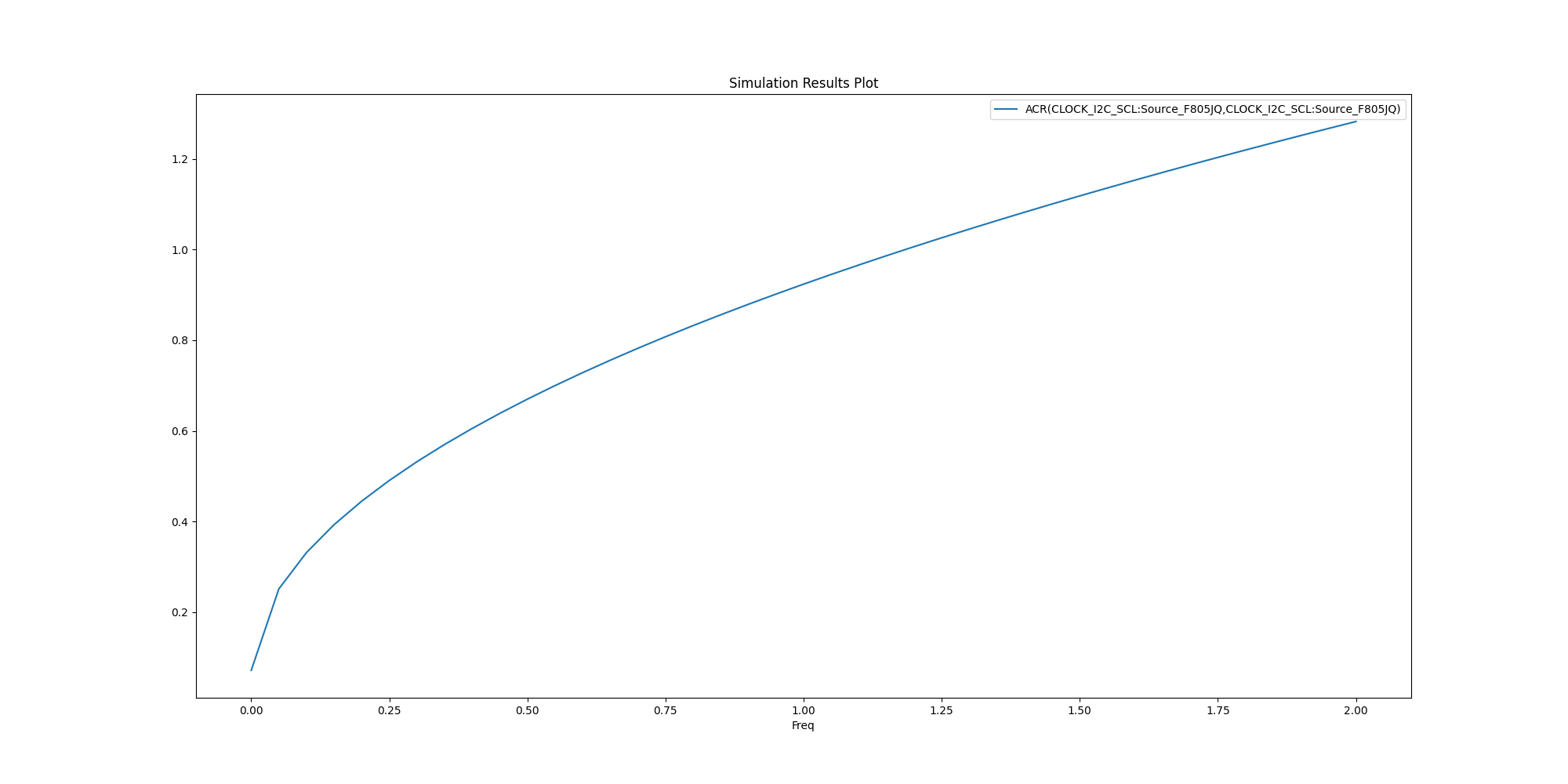Note
Go to the end to download the full example code
Q3D Extractor: PCB analysis#
This example shows how you can use PyAEDT to create a design in Q3D Extractor and run a simulation starting from an EDB Project.
Perform required imports#
Perform required imports.
import os
import tempfile
import pyaedt
Setup project files and path#
Download of needed project file and setup of temporary project directory.
project_dir = pyaedt.generate_unique_folder_name()
aedb_project = pyaedt.downloads.download_file('edb/ANSYS-HSD_V1.aedb',destination=project_dir)
project_name = pyaedt.generate_unique_name("HSD")
output_edb = os.path.join(project_dir, project_name + '.aedb')
output_q3d = os.path.join(project_dir, project_name + '_q3d.aedt')
Open EDB#
Open the edb project and created a cutout on the selected nets before exporting to Q3D.
edb = pyaedt.Edb(aedb_project, edbversion="2023.2")
edb.cutout(["CLOCK_I2C_SCL", "CLOCK_I2C_SDA"], ["GND"], output_aedb_path=output_edb,
use_pyaedt_extent_computing=True, )
C:\actions-runner\_work\pyaedt\pyaedt\testenv\lib\site-packages\pyaedt\edb_core\components.py:163: DeprecationWarning: Use new property :func:`instances` instead.
warnings.warn("Use new property :func:`instances` instead.", DeprecationWarning)
True
Identify pins position#
Identify [x,y] pin locations on the components to define where to assign sources and sinks for Q3D and append Z elevation.
pin_u13_scl = [i for i in edb.components["U13"].pins.values() if i.net_name == "CLOCK_I2C_SCL"]
pin_u1_scl = [i for i in edb.components["U1"].pins.values() if i.net_name == "CLOCK_I2C_SCL"]
pin_u13_sda = [i for i in edb.components["U13"].pins.values() if i.net_name == "CLOCK_I2C_SDA"]
pin_u1_sda = [i for i in edb.components["U1"].pins.values() if i.net_name == "CLOCK_I2C_SDA"]
Append Z Positions#
Note: The factor 100 converts from “meters” to “mm”
location_u13_scl = [i * 1000 for i in pin_u13_scl[0].position]
location_u13_scl.append(edb.components["U13"].upper_elevation * 1000)
location_u1_scl = [i * 1000 for i in pin_u1_scl[0].position]
location_u1_scl.append(edb.components["U1"].upper_elevation * 1000)
location_u13_sda = [i * 1000 for i in pin_u13_sda[0].position]
location_u13_sda.append(edb.components["U13"].upper_elevation * 1000)
location_u1_sda = [i * 1000 for i in pin_u1_sda[0].position]
location_u1_sda.append(edb.components["U1"].upper_elevation * 1000)
Save and close Edb#
Save, close Edb and open it in Hfss 3D Layout to generate the 3D model.
edb.save_edb()
edb.close_edb()
h3d = pyaedt.Hfss3dLayout(output_edb, specified_version="2023.2", non_graphical=True, new_desktop_session=True)
Initializing new desktop!
Export to Q3D#
Create a dummy setup and export the layout in Q3D. keep_net_name will reassign Q3D nets names from Hfss 3D Layout.
setup = h3d.create_setup()
setup.export_to_q3d(output_q3d, keep_net_name=True)
h3d.close_project()
Returning found desktop with PID 3176!
True
Open Q3D#
Launch the newly created q3d project and plot it.
q3d = pyaedt.Q3d(output_q3d)
q3d.plot(show=False, objects=["CLOCK_I2C_SCL", "CLOCK_I2C_SDA"],
export_path=os.path.join(q3d.working_directory, "Q3D.jpg"), plot_air_objects=False)

Returning found desktop with PID 3176!
<pyaedt.generic.plot.ModelPlotter object at 0x000001D9A65AF730>
Assing Source and Sink#
Use previously calculated position to identify faces and assign sources and sinks on nets.
f1 = q3d.modeler.get_faceid_from_position(location_u13_scl, obj_name="CLOCK_I2C_SCL")
q3d.source(f1, net_name="CLOCK_I2C_SCL")
f1 = q3d.modeler.get_faceid_from_position(location_u13_sda, obj_name="CLOCK_I2C_SDA")
q3d.source(f1, net_name="CLOCK_I2C_SDA")
f1 = q3d.modeler.get_faceid_from_position(location_u1_scl, obj_name="CLOCK_I2C_SCL")
q3d.sink(f1, net_name="CLOCK_I2C_SCL")
f1 = q3d.modeler.get_faceid_from_position(location_u1_sda, obj_name="CLOCK_I2C_SDA")
q3d.sink(f1, net_name="CLOCK_I2C_SDA")
<pyaedt.modules.Boundary.BoundaryObject object at 0x000001D983FF39A0>
Create Setup#
Create a setup and a frequency sweep from DC to 2GHz. Analyze project.
setup = q3d.create_setup()
setup.dc_enabled = True
setup.capacitance_enabled = False
sweep = setup.add_sweep()
sweep.add_subrange("LinearStep", 0, end=2, count=0.05, unit="GHz", save_single_fields=False, clear=True)
setup.analyze()
ACL Report#
Compute ACL solutions and plot them.
traces_acl = q3d.post.available_report_quantities(quantities_category="ACL Matrix")
solution = q3d.post.get_solution_data(traces_acl)
solution.plot()

<Figure size 2000x1000 with 1 Axes>
ACR Report#
Compute ACR solutions and plot them.
traces_acr = q3d.post.available_report_quantities(quantities_category="ACR Matrix")
solution2 = q3d.post.get_solution_data(traces_acr)
solution2.plot()

<Figure size 2000x1000 with 1 Axes>
Close AEDT#
After the simulation completes, you can close AEDT or release it using the
release_desktop method. All methods provide for saving projects before closing.
q3d.release_desktop()
True
Total running time of the script: (7 minutes 5.531 seconds)